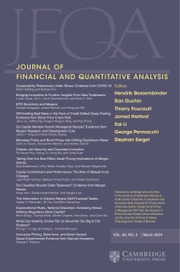No CrossRef data available.
Article contents
Disagreement and Scheduled Announcements: Explaining the Pre-Announcement Drift
Published online by Cambridge University Press: 10 September 2025
Abstract
This article proposes a theoretical explanation for the positive pre-announcement drift empirically documented ahead of scheduled announcements, using the Federal Open Market Committee (FOMC) meetings as a main example. The framework entails a general equilibrium model of disagreement (differences of opinion), where investors interpret a costly signal differently. Investors optimally decide to stop learning when an announcement is imminent, increasing the risk premium ahead of an announcement. The model jointly rationalizes puzzling empirical evidence by generating i) an upward drift in prices just before scheduled announcements, regardless of the announcement’s content, which coexists with ii) low volatility and iii) low trading volume.
Information
- Type
- Research Article
- Information
- Copyright
- © The Author(s), 2025. Published by Cambridge University Press on behalf of the Michael G. Foster School of Business, University of Washington
Footnotes
This article has benefited from the constructive comments of Thierry Foucault (the editor) and two anonymous referees. It has also benefited from discussions with Hengjie Ai, Daniel Andrei, Adrian Buss, Julio Crego, Stefano Colonnello, Bernard Dumas, Emanuel Moench, Lucie Tepla, and Jinyuan Zhang. I’m very thankful to Damir Filipovic and Martin Larsson for their help in clarifying the mathematical concepts of this article. I also wish to thank Bart Z. Yueshen for providing the data necessary for this project. I am grateful to the INSEAD faculty, the Trans-Atlantic Doctoral Conference at LBS, and the 2017 HEC PhD Conference participants for their valuable advice.

